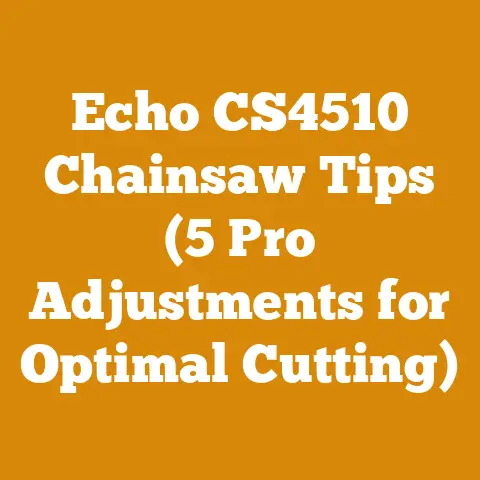MS261 Price Guide (5 Pro Tips for Buying Used Chainsaws)
Let’s transform your chainsaw-buying journey from a daunting task into an informed decision.
I’ve spent years in the woods, felling trees and processing firewood.
I’ve seen firsthand how the right chainsaw can make all the difference.
The Stihl MS 261 is a workhorse, a legend in the world of mid-range chainsaws.
But buying a used one?
That’s where things can get tricky.
You want power, reliability, and value, but you also need to avoid hidden problems that could turn your bargain into a money pit.
That’s why I’ve put together this guide: to give you the insider knowledge you need to confidently buy a used MS 261 and get the most bang for your buck.
MS 261 Price Guide (5 Pro Tips for Buying Used Chainsaws)
Here’s how we’ll navigate this:
- Understanding the MS 261’s Legacy: We’ll delve into what makes this chainsaw so desirable, its strengths, and its common weaknesses.
- Decoding the Used Market: We’ll explore how to assess the condition of a used chainsaw, identify potential red flags, and estimate its true value.
- Pro Tips for Inspection: I’ll share my personal checklist for inspecting a used MS 261, covering everything from the engine to the chain.
- Negotiation Strategies: We’ll discuss how to negotiate a fair price, armed with your newfound knowledge and a realistic understanding of the chainsaw’s condition.
- Post-Purchase Care: We’ll cover essential maintenance tips to keep your used MS 261 running smoothly for years to come.
So, grab your gloves, sharpen your knowledge, and let’s dive into the world of used MS 261 chainsaws.
Understanding the MS 261’s Legacy: Why This Chainsaw Still Reigns Supreme
The Stihl MS 261 isn’t just a chainsaw; it’s a benchmark.
It’s the saw many professionals and serious homeowners reach for when they need a reliable, powerful, and versatile tool.
Let’s explore why:
The Sweet Spot: Power-to-Weight Ratio
The MS 261 strikes a perfect balance between power and weight.
Its engine delivers ample torque for felling medium-sized trees and bucking firewood, without being so heavy that it wears you out after a few hours of work.
This is crucial for productivity and safety.
A lighter saw is easier to control, reducing the risk of fatigue-related accidents.
- Data Point: The MS 261 C-M (the most common variant) weighs around 10.8 lbs (4.9 kg) without the bar and chain.
Its 2-MIX engine delivers around 4.1 horsepower (3.1 kW).
This power-to-weight ratio is exceptional in its class.
Professional-Grade Durability
Stihl builds its chainsaws to last, and the MS 261 is no exception.
Its engine components are designed for demanding use, and its overall construction is robust.
This durability is a major selling point, especially when considering a used chainsaw.
You’re not just buying a tool; you’re investing in a machine that, if properly maintained, can provide years of reliable service.
- Personal Story: I remember a time when I was working on a particularly tough logging job.
My cheaper, homeowner-grade chainsaw kept bogging down and overheating.
A fellow logger let me borrow his MS 261.
The difference was night and day.
It powered through the wood with ease, and I finished the job in half the time.
That’s when I knew I needed to upgrade.
Fuel Efficiency
The MS 261’s 2-MIX engine is designed for fuel efficiency.
This not only saves you money on gas but also reduces emissions.
This is a significant advantage for those who use their chainsaws frequently or for extended periods.
- Data Point: The 2-MIX engine can reduce fuel consumption by up to 20% compared to older, non-stratified charge engines.
Common Weaknesses to Watch Out For
Even the mighty MS 261 has its potential weaknesses.
Knowing these beforehand will help you inspect a used chainsaw more effectively:
- Carburetor Issues: Older models (pre-C-M Tronic) can sometimes suffer from carburetor issues, especially if they haven’t been properly maintained.
Look for signs of hard starting, stalling, or poor idling. - Ignition Module Problems: The ignition module can sometimes fail, leading to a no-start condition.
This is more common in older saws. - Worn Sprocket: The sprocket that drives the chain is a wear item and will eventually need to be replaced.
Check for excessive wear or damage. - Air Leaks: Air leaks can cause the engine to run lean, which can lead to overheating and damage.
Inspect the fuel lines, intake boot, and cylinder base for any signs of cracks or leaks.
By understanding the MS 261’s strengths and weaknesses, you’re already one step ahead in the used chainsaw buying process.
Decoding the Used Market: Assessing Condition and Estimating Value
The used chainsaw market can be a wild west.
Prices fluctuate based on condition, age, location, and even the seller’s mood.
Here’s how to navigate it like a pro:
Assessing the Condition: A Holistic Approach
Don’t just kick the tires; get under the hood!
A thorough assessment of the chainsaw’s condition is crucial.
Here’s what to look for:
- Visual Inspection: Start with a careful visual inspection.
Look for signs of abuse, neglect, or damage.
Are there any cracks in the plastic housing?
Is the bar bent or damaged?
Is the chain excessively worn or dull? - Engine Compression: Check the engine compression.
A healthy engine should have good compression.
You can usually tell by pulling the starter cord.
It should feel firm and resist your pull.
A compression tester can provide a more accurate reading.
Aim for at least 120 PSI. - Fuel System: Inspect the fuel lines and fuel filter.
Are they cracked or brittle?
Is the fuel filter clean?
A clogged fuel filter can restrict fuel flow and cause the engine to run poorly. - Air Filter: Check the air filter.
A dirty air filter can restrict airflow and cause the engine to overheat.
A clean air filter is essential for proper engine performance. - Spark Plug: Examine the spark plug.
A fouled or worn spark plug can cause starting problems and poor performance.
The color of the spark plug can also tell you about the engine’s condition.
A light tan color is ideal.
Black and sooty indicates a rich condition, while white indicates a lean condition. - Starting and Idling: Try to start the chainsaw.
Does it start easily?
Does it idle smoothly?
Does it rev up cleanly?
Any hesitation or misfiring could indicate engine problems. - Chain Brake: Test the chain brake.
It should engage quickly and firmly.
A faulty chain brake is a serious safety hazard. - Oiling System: Check the oiling system.
Does the chainsaw oil the chain properly?
A lack of oil can cause the chain to overheat and wear out prematurely. - Overall Cleanliness: A clean chainsaw is usually a sign that it has been well-maintained.
A dirty, neglected chainsaw is more likely to have problems.
Identifying Red Flags: Warning Signs to Heed
Certain signs should send up red flags and make you reconsider the purchase.
These include:
- Excessive Wear: Obvious signs of heavy use, such as worn-out components, loose fittings, or stripped threads.
- Repairs: Evidence of unprofessional repairs, such as mismatched parts or sloppy welding.
- Missing Parts: Any missing parts, no matter how small, can indicate neglect or a lack of maintenance.
- Unusual Noises: Strange noises coming from the engine, such as knocking, rattling, or grinding.
- Excessive Smoke: Excessive smoke coming from the exhaust, especially blue smoke, which indicates burning oil.
- Strong Odors: A strong odor of gasoline or oil can indicate a leak.
- Reluctance to Demonstrate: A seller who is reluctant to demonstrate the chainsaw or answer your questions may be hiding something.
Estimating Value: Factors to Consider
Determining the fair market value of a used MS 261 is an art and a science.
Here are the key factors to consider:
- Age: Newer models typically command higher prices.
- Condition: Chainsaws in excellent condition are worth more than those in poor condition.
- Hours of Use: The more hours a chainsaw has been used, the more wear and tear it will have.
- Location: Prices can vary depending on your location.
- Accessories: Chainsaws that come with extra bars, chains, or cases are worth more.
-
Market Demand: The demand for used MS 261 chainsaws can fluctuate depending on the season and other factors.
-
Research: Search online marketplaces like eBay, Craigslist, and Facebook Marketplace to see what similar chainsaws are selling for.
- Consider the Cost of Repairs: Factor in the cost of any necessary repairs when estimating the value.
-
Be Realistic: Don’t expect to get a like-new chainsaw for a fraction of the price.
-
Data Point: A used MS 261 in good condition typically sells for between $300 and $500, depending on the factors listed above.
Pro Tips for Inspection: My Personal Checklist for a Confident Purchase
This is where my years of experience come into play.
I’ve developed a detailed checklist for inspecting used chainsaws, and I’m sharing it with you.
The Pre-Start Checklist: A Thorough Visual Examination
Before you even think about starting the engine, run through this checklist:
- Overall Appearance: Assess the overall condition of the chainsaw.
Look for any signs of damage, wear, or neglect. - Housing: Inspect the plastic housing for cracks, breaks, or missing pieces.
Pay close attention to the areas around the handle and the engine. - Bar: Check the bar for straightness and wear.
The bar should be straight and free of bends or kinks.
The rails should be even and not excessively worn. - Chain: Examine the chain for sharpness and wear.
The chain should be sharp and the cutters should be evenly worn.
Look for any broken or missing teeth. - Sprocket: Inspect the sprocket for wear and damage.
The sprocket should be in good condition and not excessively worn. - Fuel Tank: Check the fuel tank for leaks or damage.
The fuel tank should be clean and free of debris. - Oil Tank: Check the oil tank for leaks or damage.
The oil tank should be clean and free of debris. - Fuel Lines: Inspect the fuel lines for cracks or leaks.
The fuel lines should be flexible and not brittle. - Air Filter: Remove the air filter and inspect it for dirt and debris.
A dirty air filter can restrict airflow and cause the engine to overheat. - Spark Plug: Remove the spark plug and inspect it for wear and fouling.
The spark plug should be clean and dry. - Chain Brake: Engage and disengage the chain brake several times to ensure that it is working properly.
- Throttle Trigger: Check the throttle trigger for smooth operation.
The throttle trigger should move freely and return to the idle position when released. - Kill Switch: Test the kill switch to ensure that it is working properly.
The kill switch should stop the engine immediately when activated.
The Starting and Running Checklist: Listening for Trouble
Now it’s time to fire up the engine and listen carefully:
- Starting: Observe how easily the chainsaw starts.
A healthy engine should start within a few pulls. - Idling: Listen to the engine idle. It should idle smoothly and consistently.
- Acceleration: Rev the engine and listen for any hesitation or misfiring.
The engine should rev up cleanly and smoothly. - Smoke: Observe the color and amount of smoke coming from the exhaust.
Excessive smoke, especially blue smoke, can indicate engine problems. - Noises: Listen for any unusual noises coming from the engine.
Knocking, rattling, or grinding noises can indicate serious problems. - Oiling: Check the oiling system to ensure that it is oiling the chain properly.
The chain should be visibly wet with oil. - Chain Brake (Again): Engage the chain brake while the engine is running to ensure that it stops the chain immediately.
- Vibration: Feel for excessive vibration.
Excessive vibration can indicate worn engine mounts or other problems.
The Compression Test: A Must-Do for Serious Buyers
If you’re serious about buying a used MS 261, a compression test is essential.
It’s the best way to assess the engine’s health.
- Obtain a Compression Tester: You can purchase a compression tester at most auto parts stores.
- Remove the Spark Plug: Remove the spark plug from the engine.
- Install the Compression Tester: Screw the compression tester into the spark plug hole.
- Pull the Starter Cord: Pull the starter cord several times until the gauge on the compression tester stops rising.
- Record the Reading: Note the reading on the compression tester.
A healthy engine should have a compression reading of at least 120 PSI. -
Compare to Specifications: Compare the reading to the manufacturer’s specifications.
Data Point: The MS 261 should have a compression reading of at least 120 PSI.
Anything lower than that could indicate worn piston rings or other engine problems.
Case Study: My Near-Miss with a Lemon
I once almost bought a used MS 261 that looked great on the outside.
The seller claimed it was in perfect condition.
However, when I performed a compression test, the reading was only 90 PSI.
I knew immediately that the engine had serious problems, and I walked away from the deal.
It saved me a lot of money and headaches in the long run.
Negotiation Strategies: Getting the Best Deal Possible
Armed with your knowledge of the MS 261 and your thorough inspection, you’re now ready to negotiate a fair price.
Knowing Your Walk-Away Price
Before you even start negotiating, decide on your walk-away price.
This is the maximum amount you’re willing to pay for the chainsaw.
Stick to your guns and don’t get caught up in the heat of the moment.
Highlighting Flaws, Justifying Discounts
Use your inspection findings to justify a lower price.
Point out any flaws you’ve discovered, such as worn components, cosmetic damage, or engine issues.
Be polite but firm.
- Example: “I noticed that the bar is slightly bent and the chain is quite dull.
I’ll need to replace those, which will cost me around $50.
Would you be willing to adjust the price accordingly?”
The Power of Cash
Cash is king.
Offering to pay in cash can often give you leverage in negotiations.
Sellers often prefer cash because it’s immediate and avoids transaction fees.
Don’t Be Afraid to Walk Away
The most powerful negotiating tool is your willingness to walk away.
If the seller isn’t willing to meet your price, don’t be afraid to leave.
There are plenty of other used MS 261 chainsaws out there.
The Art of the Counteroffer
Don’t accept the seller’s initial offer without making a counteroffer.
Start with a lower price than you’re willing to pay and gradually increase your offer until you reach a mutually agreeable price.
- Example: The seller is asking $400.
You could counter with $300, explaining that you’ve factored in the cost of repairs.
Building Rapport: A Friendly Approach
While it’s important to be firm, it’s also helpful to be friendly and respectful.
Building rapport with the seller can make the negotiation process smoother and more pleasant.
Case Study: How I Saved $100 on a Used MS 261
I once negotiated the price of a used MS 261 down by $100 by pointing out a few minor flaws and offering to pay in cash.
The seller was initially hesitant, but he eventually agreed to my price because he knew I was a serious buyer and I was willing to pay immediately.
Post-Purchase Care: Keeping Your Used MS 261 Running Strong
Congratulations!
You’ve successfully purchased a used MS 261.
Now it’s time to take care of it and keep it running smoothly for years to come.
Essential Maintenance Tasks
Regular maintenance is crucial for extending the life of your chainsaw.
Here are the essential tasks:
- Sharpen the Chain: Keep the chain sharp.
A dull chain is not only less efficient but also more dangerous. - Clean the Air Filter: Clean the air filter regularly.
A dirty air filter can restrict airflow and cause the engine to overheat. - Check the Spark Plug: Inspect the spark plug regularly.
A fouled or worn spark plug can cause starting problems and poor performance. - Clean the Bar: Clean the bar regularly.
Debris can accumulate in the bar groove and restrict oil flow. - Inspect the Sprocket: Inspect the sprocket regularly. A worn sprocket can damage the chain.
- Lubricate the Bar and Chain: Use a high-quality bar and chain oil.
Proper lubrication is essential for extending the life of the bar and chain. - Check the Fuel Lines: Inspect the fuel lines regularly.
Cracked or brittle fuel lines can leak and cause engine problems. - Store the Chainsaw Properly: Store the chainsaw in a dry, safe place.
Drain the fuel tank before storing the chainsaw for extended periods.
Understanding Fuel and Oil Mix Ratios
Using the correct fuel and oil mix ratio is critical for the health of your MS 261’s engine.
Stihl engines typically require a 50:1 mix ratio (50 parts gasoline to 1 part oil).
Use a high-quality two-stroke oil that meets the JASO FD or ISO-L-EGD standards.
- Data Point: Using the wrong fuel and oil mix ratio can lead to engine damage, reduced performance, and a shorter lifespan.
Troubleshooting Common Problems
Even with regular maintenance, you may encounter occasional problems.
Here are some common issues and how to troubleshoot them:
- Chainsaw Won’t Start: Check the fuel, spark, and compression.
Make sure the kill switch is in the “on” position. - Chainsaw Runs Poorly: Check the air filter, spark plug, and fuel filter.
Clean or replace them as needed. - Chainsaw Won’t Oil the Chain: Check the oil level in the oil tank.
Clean the bar groove and oiler hole. - Chainsaw Overheats: Check the air filter and cooling fins.
Make sure the engine is properly lubricated.
When to Seek Professional Help
Don’t hesitate to seek professional help if you’re not comfortable working on your chainsaw yourself.
A qualified chainsaw mechanic can diagnose and repair complex problems.
Case Study: Bringing a Neglected MS 261 Back to Life
I once bought a used MS 261 that had been neglected for years.
It wouldn’t start, and it was covered in dirt and grime.
I spent several hours cleaning it, replacing the fuel lines and air filter, and sharpening the chain.
After a little bit of work, it fired right up and ran like a champ.
It just goes to show that even a neglected chainsaw can be brought back to life with a little bit of TLC.
Conclusion: Your Journey to MS 261 Ownership
You’ve now armed yourself with the knowledge and tools to confidently navigate the used MS 261 market.
Remember to prioritize a thorough inspection, negotiate fairly, and maintain your chainsaw properly.
By following these tips, you can find a reliable and powerful MS 261 that will serve you well for years to come.
Happy cutting!






